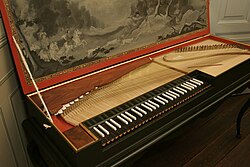
In the historically informed performance movement, musicians perform classical music using restored or replicated versions of the instruments for which it was originally written. Often performances by such musicians are said to be "on authentic instruments".
Contents
- Renaissance (1400–1600)
- Strings
- Woodwinds
- Brasses
- Keyboards
- Percussion
- Baroque (1600–1750)
- Strings 2
- Woodwind
- Brasses 2
- Keyboards 2
- Percussion 2
- Classical (1750–1820)
- Strings 3
- Woodwinds 2
- Keyboards 3
- Brasses 3
- Percussion 3
- See also
- External links
This article consists of a list of such instruments in the European tradition, including both instruments that are now obsolete and early versions of instruments that continued to be used in later classical music.



